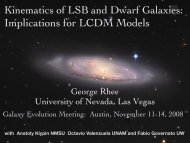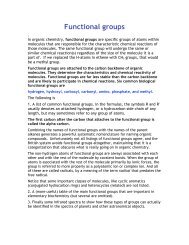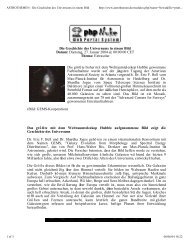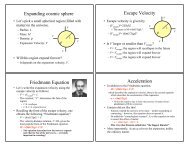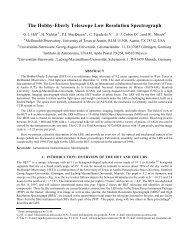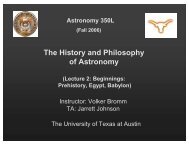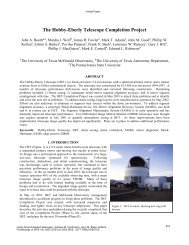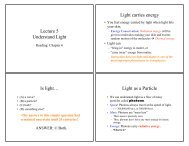COMPOSITION OF THE ORION NEBULA
COMPOSITION OF THE ORION NEBULA
COMPOSITION OF THE ORION NEBULA
You also want an ePaper? Increase the reach of your titles
YUMPU automatically turns print PDFs into web optimized ePapers that Google loves.
Kathryn Powell & Dr. Reginald Dufour<br />
Rice University<br />
<strong>COMPOSITION</strong> <strong>OF</strong> <strong>THE</strong><br />
<strong>ORION</strong> <strong>NEBULA</strong><br />
Using the Hubble Space<br />
Telescope Faint Object<br />
Spectrograph
Motivation<br />
• Analyze elemental abundances in the Orion<br />
Nebula with HST FOS data<br />
• Ability to analyze data from UV and visible<br />
regions with the same instrument observing<br />
the same position in the nebula<br />
• UV data enables determination of carbon<br />
abundances
• Clouds of ionized gas<br />
• Regions of recent star<br />
formation<br />
• Orion Nebula is the<br />
closest H II region<br />
(1344 light years)<br />
HII regions
Collisionally excited lines<br />
• “Forbidden” lines<br />
– Transitions produce lines not observed in the<br />
lab; very unlikely under normal conditions<br />
– Observed in low-‐density gases where atomic<br />
collisions are infrequent, like H II regions!<br />
– Notated by square brackets: O++ [O III]<br />
• Measure the intensities of these lines to<br />
learn about conditions in the nebula
Measuring Line Intensi)es
€<br />
reddening-‐<br />
corrected flux<br />
Reddening Correc)on<br />
I(λ)<br />
I(Hβ)<br />
c = log 10(2.86) − log(Hα Hβ)<br />
−0.274<br />
F(λ) f (λ)− f ( Hβ )]<br />
= 10c[<br />
F(Hβ)<br />
measured flux<br />
extinction correction<br />
parameter that varies<br />
with wavelength<br />
Hα, Hβ : Balmer lines of hydrogen
nebular<br />
• Package in Space Telescope Science Data<br />
Analysis System<br />
• Shaw & Dufour (1995)<br />
• Calculate temperatures, densities, and<br />
abundances in IRAF
Temperature and Density Calculations<br />
• Strength of the<br />
forbidden lines is very<br />
sensitive to<br />
temperature<br />
• Due to weak/noisy lines<br />
needed to determine<br />
€<br />
temperature, values<br />
presented here are<br />
from the literature€<br />
€<br />
T e (OIII) =<br />
T e(NII) =<br />
(4959 +5007)<br />
4363<br />
(6548 + 6584)<br />
5755<br />
N e (SII) = 6716<br />
6731
Abundance Calcula)ons<br />
Ionic abundances Total elemental abundances<br />
O/H = (O + +O ++ )/H +<br />
S/H = (S + + S ++ )/H +<br />
N/H = (N + /O + )*(O/H)<br />
Ne/H = (Ne ++ /O ++ )*(O/H)<br />
C/H = (C ++ /O ++ )*(O/H)<br />
-‐Where possible, sum the<br />
contribution from multiple<br />
excitation states<br />
-‐Otherwise, take advantage of<br />
similar ionization potentials<br />
and use O/H correction factor<br />
-‐log(X/H) + 12
Elemental Abundances<br />
log(X/H) + 12<br />
Object C N O Ne S<br />
Orion 1SW 8.66 7.88 8.46 7.76 6.98<br />
Orion X2 8.44 7.65 8.51 7.64 6.95<br />
Orion* 8.39 7.62 8.48 7.70 6.97<br />
Solar* 8.59 7.92 8.69 8.08 7.32<br />
*Stasinska, G. (2004) In Cosmochemistry: The Melting Pot of the Elements, Cambridge U. Press.
Conclusions<br />
• Determined elemental abundances in the<br />
Orion Nebula from collisionally excited<br />
spectral lines<br />
• Found consistent abundances with FOS<br />
spectra<br />
– Oxygen consistent with literature<br />
– Carbon within reasonable limits<br />
• Not able to determine temperatures precisely<br />
enough with HST FOS



